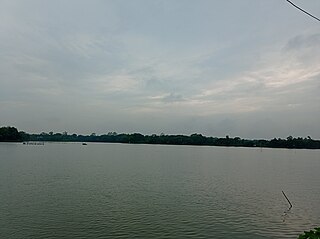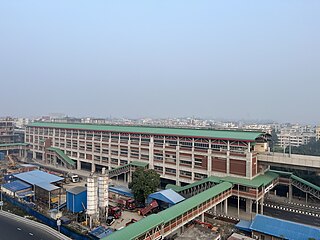
Dhaka, formerly known as Dacca, is the capital and largest city of Bangladesh. It is the ninth-largest and seventh-most densely populated city in the world with a density of 23,234 people per square kilometer within a total area of approximately 300 square kilometers. Dhaka is a megacity, and has a population of 10.2 million residents as of 2024, and a population of over 23.9 million residents in Dhaka Metropolitan Area. It is widely considered to be the most densely populated built-up urban area in the world. Dhaka is the most important cultural, economic, and scientific hub of Eastern South Asia, as well as a major Muslim-majority city. Dhaka ranks third in South Asia and 39th in the world in terms of GDP. Lying on the Ganges Delta, it is bounded by the Buriganga, Turag, Dhaleshwari and Shitalakshya rivers. Dhaka is also the largest Bengali-speaking city in the world.

The Jatiya Sangsad Bhaban is the house of the Parliament of Bangladesh, located at Sher-e-Bangla Nagar besides St. Joseph Higher Secondary School in the Bangladeshi capital of Dhaka. Designed while the country was still part of Pakistan by architect Louis Kahn, the complex is one of the largest legislative complexes in the world, covering 208 acres (840,000 m2).

Kamalapur Railway Station, officially Dhaka Railway Station, is the central railway station in Kamalapur, Dhaka, capital of Bangladesh. It is the largest station and the busiest infrastructure for transportation in the country that acts as a gateway of the country's capital. It was opened on 1 May 1968.

Shahbagh is a major neighbourhood and a police precinct or thana in Dhaka, the capital and largest city of Bangladesh. It is also a major public transport hub. It is a junction between two contrasting sections of the city—Old Dhaka and New Dhaka—which lie, respectively, to its south and north. Developed in the 17th century during Mughal rule in Bengal, when Old Dhaka was the provincial capital and a centre of the flourishing muslin industry, it came to neglect and decay in early 19th century. In the mid-19th century, the Shahbagh area was developed as New Dhaka became a provincial centre of the British Raj, ending a century of decline brought on by the passing of Mughal rule.

Paltan is a thana (precinct) of Dhaka, the capital of Bangladesh. It is often said to be the center of Dhaka, dividing "Old Dhaka" and "New Dhaka". Paltan was made a thana in 2005 by then Prime Minister Begum Khaleda Zia. Paltan Thana was formed on 27 June 2005 comprising part of Motijheel thana.

Fulbaria is an upazila of the Mymensingh District in Bangladesh.
Motijheel is a central business district and a thana of Dhaka, Bangladesh. It is Dhaka's primary central business district, and also the nation's largest commercial and financial hub. Motijheel, located immediately adjacent to Dhaka's zero point, has the largest number of offices in Dhaka. Motijheel CBD also has one of the highest concentrations of high-rise buildings in Bangladesh. It has thus earned the title of the downtown and city centre of Dhaka and as the bankpara-officepara in Bengali.

Ramna is a thana (precinct) in central Dhaka and a historic colonial neighbourhood. Once the site of Mughal gardens, it developed into an institutional area during British rule in the late 19th century. It became a focal point for Dhaka's modernisation in the 1960s. It was the scene of many tumultuous events that ushered the independence of Bangladesh in 1971. Ramna Thana falls under the jurisdiction of Dhaka South City Corporation.
Sabujbagh is a thana in Dhaka District in the Division of Dhaka, Bangladesh. Situated in the administrative area of Dhaka South City Corporation, the thana was formed in 1988. The police station is located at holding number 203 in Middle Bashabo.

Tejgaon is a thana of Dhaka District in the Division of Dhaka, Bangladesh. It is in the centre of Dhaka, the capital. In 2006, the boundaries of the thana were redrawn when Tejgaon Industrial Area Thana was created out of the former larger area and again in 2009, when Sher-e-Bangla Nagar Thana was created.
Khilgaon is a thana and neighbourhood in the city of Dhaka, Bangladesh. The thana encompasses Dhaka South City Corporation wards 24, 25, and 26. In 2022, it had a population of about 380 thousand.

Farmgate is an area in Dhaka, the capital of Bangladesh. It is one of the busiest and most crowded areas of Dhaka city. From the early 90s', the area has seen the massive building and construction boom. Consequently, the area has gained commercial importance and became one of the major transportation hubs of Dhaka from where anyone can travel to all other parts of the city and throughout the country. Line 6 of the Dhaka Metro Rail has a station there. Today Farmgate has become more of a commercial area than a residential area. Neighboring places of Farmgate are Shahbagh, Kawran Bazar, Panthapath, National Parliament, Rajabazar and Bijoy Soroni.

Airport Road, also known as Tongi Diversion Road, a part of the Dhaka-Mymensingh Highway (N3), is an 8-lane major artery road in Dhaka, that connects Dhaka city, with the Shahjalal International Airport. It is also the main artery that connects Dhaka with the northern suburb of Uttara and the only road that connects Dhaka with northern Districts of Bangladesh and vice versa. Traffic is fairly smooth throughout the road, due to flyovers and interchanges.
Obaidul Karim is a Bangladeshi businessman and the founder and chairman of Orion Group. He is the president of sporting club Mohammedan SC Limited. He is an innovative, enterprising Bangladeshi business icon who has instrumented his success in the field of diversified business portfolios..

Hatirjheel is a lakefront in Dhaka, Bangladesh with surrounding roads and bridges built to ease traffic congestion.
Shantinagar is an upscale neighbourhood located in Dhaka, the capital of Bangladesh. It is under Paltan Thana. Shantinagar is administered by Dhaka South City Corporation. It is also one of the busiest areas in Dhaka. Its neighbouring areas are Bailey Road, Siddeshwari, Segunbagicha, Paltan, Rajarbagh and Kakrail. Numerous shops, pharmacies, restaurants and salons can be found in Shantinagar. Eastern Plus Shopping Complex is also located in Shantinagar which is a well-known place for shopping around the locality.

Transport in Dhaka consists of a mixture of cars, buses, rickshaws, motorcycles, and pedestrians, all vying for space in an environment where congestion is a daily challenge. The slowest city in the world, average traffic speed is less than seven kilometres per hour (4.3 mph), and congestion was estimated to cost the economy US$6.5 billion in 2020.
Bangabazar is a bazaar Located in Fulbaria, Dhaka. It is mainly known as the market for the ready-made garment industry. Until the mid-1950s, the Old Dhaka railway station was at Fulbaria. This market is mainly built around this station. Currently, it is managed by Dhaka South City Corporation. It is one of the leading garment markets in the country.













